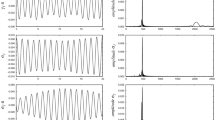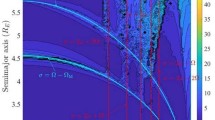Abstract
On time scales of interest for mission planning of GNSS satellites, the qualitative motion of the semimajor axis and the node evolves primarily from resonances with the Earth’s gravitational field. The relevant dynamics of GPS orbits, which are in deep 2 to 1 resonance, is modeled with an integrable intermediary that depends only on one angle, the stroboscopic mean node, plus a two degrees of freedom perturbation that is factored by the eccentricity. Results are compared with long-term runs of the GTDS DSST showing very good agreement.
Similar content being viewed by others
References
ROSSI, A. “Resonant dynamics of Medium Earth Orbits: Space Debris Issues,” Celestial Mechanics and Dynamical Astronomy, Vol. 100, No. 4, 2008, pp. 267–286.
ANSELMO, L. and PARDINI, C., “Long-Term Dynamical Evolution of High Area-to-Mass Ratio Debris Released into High Earth Orbits,” Acta Astronautica, Vol. 67, 2010, pp. 204–216.
ANSELMO, L. and PARDINI, C. “Dynamical Evolution of High Area-to-Mass Ratio Debris Released into GPS Orbits,” Advances in Space Research, Vol. 43, 2009, pp. 1491–1508.
ELY, T.A. and HOWELL, K.C. “Long Term Evolution of Artificial Satellite Orbits due to Resonant Tesseral Harmonics,” The Journal of the Astronautical Sciences Vol. 44, 1996, pp. 167–190.
ELY, T.A. and HOWELL, K.C. “Dynamics of Artificial Satellite Orbits with Tesseral Resonances Including the Effects of Luni-Solar Perturbations,” International Journal of Dynamics and Stability of Systems, Vol. 12, No. 4, 1997, pp. 243–269.
ELY, T.A. and HOWELL, K.C. “East-West Stationkeeping of Satellite Orbits with Resonant Tesseral Harmonics,” Acta Astronautica, Vol. 46, No. 1, 2000, pp. 1–15.
FERREIRA, L.D.D. and VILHENA DE MORAES, R. “GPS Satellites Orbits: Resonance,” Mathematical Problems in Engineering, Vol. 2009, Article ID 347835, 12 pp.
DELEFLIE, F., LEGENDRE, P., EXERTIER, P. and BARLIER, F. “Long Term Evolution of the Galileo Constellation due to Gravitational Forces,” Advances in Space Research, Vol. 36, 2005, pp. 402–411.
GARFINKEL, B. “Formal Solution in the Problem of Small Divisors,” Astronomical Journal, Vol. 71, No. 8, 1966, pp. 657–669.
BROUWER, D. and CLEMENCE, G.M. Methods of Celestial Mechanics, Academic Press, New York and London, 1961, pp. 296ff.
BOCCALETTI, D. and PUCACCO, G. Theory of Orbits. 2: Perturbative and Geometrical Methods, Springer, A&A library, 1998, p. 10.
ALLAN, R.R. “Resonance Effects due to the Longitude Dependence of the Gravitational Field of a Rotating Primary,” Planetary and Space Science, Vol. 15, 1967, pp. 53–76.
LANE, M.T. “An Analytical Treatment of Resonance Effects on Satellite Orbits,” Celestial Mechanics, Vol. 42, Nos. 1–4, 1988, pp. 3–38.
SOCHILINA, A.S. “On the Motion of a Satellite in Resonance with Its Rotating Plane,” Celestial Mechanics, Vol. 26, No. 4, 1982, pp. 337–352.
GEDEON, G.S. “Tesseral Resonance Effects on Satellite Orbits,” Celestial Mechanics, Vol. 1, No. 2, 1969, pp. 167–189.
KAMEL, A., EKMAN, D. and TIBBITTS, R. “East-West Stationkeeping Requirements of Nearly Synchronous Satellites due to Earth Triaxiality and Luni-Solar Effects,” Celestial Mechanics, Vol. 8, No. 1, 1973, pp. 129–148.
ELY, T.A. “Eccentricity Impact on East-West Stationkeeping for Global Positioning System Class Orbits,” Journal of Guidance, Control and Dynamics, Vol. 25, No. 2, 2002, pp. 352–357.
BOHLIN, K. “Zur Frage der Convergenz der Reihenentwickelungen in der Störungstheorie,” Astronomische Nachrichten, Vol. 121, No. 2, 1889, 17–24.
FERRAZ-MELLO, S. Canonical Perturbation Theories. Degenerate Systems and Resonance, 2007, Astrophysics and Space Science Library, Vol. 345, Springer.
ROMANOWICZ, B.A. “On the Tesseral-Harmonics Resonance Problem in Artificial-Satellite Theory,” SAO Special Report 365, 1975, 52 pp; Part II, SAO Special Report 373, 1976, 30 pp.
MOORE, P. “A Resonant Problem of Two Degrees of Freedom,” Celestial Mechanics, Vol. 30, No. 1, 1983, pp. 31–47.
MOORE, P. “A Problem of Libration with Two Degrees of Freedom,” Celestial Mechanics, Vol. 33, No. 1, 1984, pp. 49–69.
VALK, S., LEMAÎTRE, A. and DELEFLIE, F. “Semi-Analytical Theory of Mean Orbital Motion for Geosynchronous Space Debris under Gravitational Influence,” Advances in Space Research, Vol. 43, 2009, pp. 1070–1082.
MCCLAIN, W. D. A Recursively Formulated First-Order Semianalytic Artificial Satellite Theory Based on the Generalized Method of Averaging, Volume 1: The Generalized Method of Averaging Applied to the Artificial Satellite Problem, Computer Sciences Corporation CSC/TR-77/6010, 1977 (“the blue book”). Also: A Semianalytic Artificial Satellite Theory. Volume 1. Application of the Generalized Method of Averaging to the Artificial Satellite Problem, 1992.
DANIELSON, D.A., NETA, B. and EARLY, L.W. Semianalytic Satellite Theory (SST): Mathematical Algorithms, Naval Postgraduate School, NPS Report NPS-MA-94-001, January 1994.
FONTE, D.J., Implementing a 50 × 50 Gravity Field in an Orbit Determination System, Master of Science Thesis, Department of Aeronautics and Astronautics, Massachusetts Institute of Technology, CSDL-T-1169. June 1993.
SCHUTZ, B.E. and CRAIG, D.E. “GPS Orbit Evolution: 1998–2000,” Proceedings of the AIAA/AAS Astrodynamics Specialist Conference, Denver, Colorado, Aug 14–17, 2000.
INEICHEN, D., BEUTLER, G. and HUGENTOBLER, U. “Sensitivity of GPS and GLONASS Orbits with Respect to Resonant Geopotential Parameters,” Journal of Geodesy, Vol. 77, 2003, pp. 478–486.
FROIDEVAL, L. and SCHUTZ, B.E. “Long arc Analysis of GPS Orbits,” Advances in the Astronautical Sciences, Vol. 124, 2006, pp. 653–664.
HORI, G.-I. “Theory of General Perturbation with Unspecified Canonical Variable,” Publications of the Astronomical Society of Japan, Vol. 18, No. 4, 1966, pp. 287–296.
DEPRIT, A. 1969 “Canonical Transformations Depending on a Small Parameter,” Celestial Mechanics, Vol. 1, No. 1, pp. 12–30.
CAMPBELL, J.A. and JEFFERYS, W.H. “Equivalence of the Perturbation Theories of Hori and Deprit,” Celestial Mechanics, Vol. 2, No. 4, 1970, pp. 467–473.
DEPRIT, A. “Delaunay Normalisations,” Celestial Mechanics, Vol. 26, No. 1, 1982, pp. 9–21.
SCHUTZ, B.E. “Numerical Studies in the Vicinity of GPS Deep Resonance,” Advances in the Astronautical Sciences, Vol. 105, 2000, pp. 287–302.
BROUCKE, R. and CEFOLA, P.J. “On the Equinoctial Orbit Elements,” Celestial Mechanics, Vol. 5, No. 3, 1972, pp. 303–310.
HINTZ, G.R. “Survey of Orbit Element Sets,” Journal of Guidance, Control and Dynamics, vol. 31, no. 3, 2008, pp. 785–790.
DELHAISE, F. and HENRARD, J. “The Problem of Critical Inclination Combined with a Resonance in Mean Motion in Artificial Satellite Theory,” Celestial Mechanics and Dynamical Astronomy, Vol. 55, 1993, pp. 261–153.
KOZAI, Y. “Second-Order Solution of Artificial Satellite Theory without Air Drag,” Astronomical Journal, Vol. 67, No. 7, 1962, pp. 446–461.
DEPRIT, A. and ROM, A. “The Main Problem of Artificial Satellite Theory for Small and Moderate Eccentricities,” Celestial Mechanics, Vol. 2, No. 2, 1970, pp. 166–206.
MÉTRIS, G. Théorie du mouvement des satellites artificiels — Développement des équations du mouvement moyen — Application à l’étude des longues périodes, Ph.D. Dissertation, Observatoire de Paris, 1991, 188 p.
LYDDANE, R.H. “Small Eccentricities or Inclinations in the Brouwer Theory of the Artificial Satellite,” Astronomical Journal, Vol. 68, 1963, pp. 555–558.
CHAO, C.-C.G. Applied Orbit Perturbation and Maintenance, The Aerospace Press, El Segundo, California — AIAA Inc., Reston, Virginia, 2005, p. 87.
LARA, M., SAN-JUAN, J.F. and CEFOLA, P. “Long-Term Evolution of Galileo Operational Orbits by Canonical Perturbation Theory,” presented as paper IAC-C1.3.9 at the, 62nd International Astronautical Congress, Cape Town, South Africa, 2011.
GARFINKEL, B. “A Theory of Libration,” Celestial Mechanics, Vol. 13, No. 2, 1976, pp. 229–246.
KAULA, W.M. Theory of Satellite Geodesy, Blaisdell Publishing Company, Waltham, Massachusetts, 1966, p. 50. Reprinted by Dover Publications, Inc., Mineola, N.Y., 2000.
SANDERS, J.A. and VERHULST, F. Averaging Methods in Nonlinear Dynamical Systems, Berlin-Heidelberg-New York-Tokyo, Springer-Verlag 1985.
PROULX, R., MCCLAIN, W., EARLY, L. and CEFOLA, P. “A Theory for the Short Periodic Motion due to the Tesseral Harmonic Gravity Field,” presented as paper AAS 81-180 at the AAS/AIAA Astrodynamics Conference, North Lake Tahoe, Nev., August 1981.
CEFOLA, P. and BROUCKE, R. “On the Formulation of the Gravitational Potential in Terms of Equinoctial Variables,” presented as paper AIAA 75-9 at the AIAA 13th Aerospace Sciences Meeting, Pasadena, CA, January 1975.
PARDINI, C. and ANSELMO, L. SATRAP: Satellite Reentry Analysis Program, Internal Report C94-17, CNUCE/CNR, Pisa, Italy, 30 August 1994.
CHAO, C.C. and GICK, R.A. “Long-Term Evolution of Navigation Satellite Orbits: GPS/GLONASS/GALILEO,” Advances in Space Research, Vol. 34, 2004, pp. 1221–1226.
DELEFLIE, F., ROSSI, A., PORTMANN, C, MÉTRIS, G. and BARLIER, F. “Semi-Analytical Investigations of the Long Term Evolution of the Eccentricity of Galileo and GPS-Like Orbits,” Advances in Space Research, Vol. 47, 2011, pp. 811–821.
CARTER, S.S. Precision Orbit Determination From GPS Receiver Navigation Solutions, Master of Science Thesis, Department of Aeronautics and Astronautics, Massachusetts Institute of Technology. CSDL-T-1260, June 1996.
LARA, M., SAN-JUAN, J.F., FOLCIK, Z.J. and CEFOLA, P. “Deep Resonant GPS-Dynamics due to the Geopotential,” Advances in the Astronautical Sciences, Vol. 140, 2011, pp. 1985–2004.
Author information
Authors and Affiliations
Corresponding author
Rights and permissions
About this article
Cite this article
Lara, M., San-Juan, J.F., Folcik, Z.J. et al. Deep Resonant GPS-Dynamics Due to the Geopotential. J of Astronaut Sci 58, 661–676 (2011). https://doi.org/10.1007/BF03321536
Published:
Issue Date:
DOI: https://doi.org/10.1007/BF03321536




